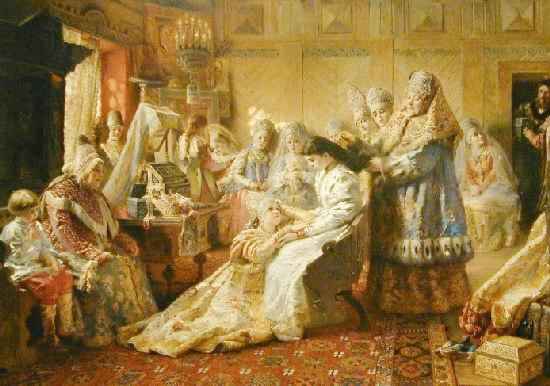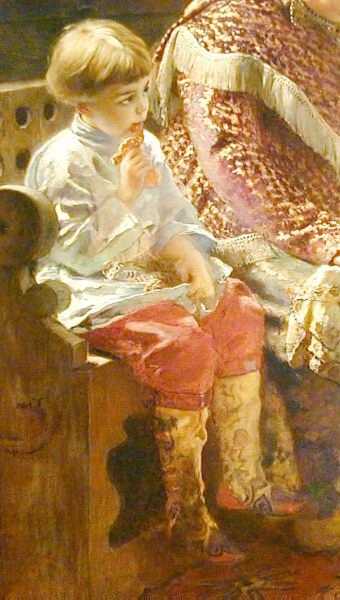
Artists Illustrating Boys' Fashions: Konstantin Ergorovich Makovsky (Russia, 1839-1915)

Figure 1.--This Makowsky painting hangs in the California Palace of the Legion of Honour in San Francisco. The title is, "The Russian Bride's Attire". It is one of his many historical depictions of Boyar life. It was painted in 1889, but I'm not sure what period it was intended to depict, but probably the 16th or 17th century. Notice the attire of the little boy at the left.
|
Konstantin Makovsky is best known as a painter of Russian folk scenes, especially of rural peasant life. As a result he provides us some fascinating depictions of how Russian boys dressed in the 19th century. His paintings are highly detailed and very accurate. He was a founding member of the revolutionary movement known as the "Wanderers". He established himself in an early phase of his career as a champion of Russian subject matter. He had an enormous impact on the direction of art in Tsarist Russia. He advocated freedom from restrictive Academic rules and subject matter.
Childhood
We have no information on Konstantin's childhood or the clothes he wore as a boy.
Education
We have no information on Konstantin's education.
Career
Makovsky's paintings became extremely popular with the 19th century Russian public, but not always with critics. His wwork evoked the romance, color, extravagance, and theatricality that he and his contemporaries imagined had existed in Russian historical eras.
Body of Work
Makovsky's work is one of the best examples of the growing realism of 19th century Russian painters. One also sinces the dawning nationalism of mid-19th century Russia in his early work. Makovsky is best known as a painter of Russian folk scenes, especially of rural peasant life. Historical scenes depicting important events in Russian history were another favorite. A good example is a huge painting (42 m. sq.) is Kozma Minin's speech before the citizens of Nizhni Novgorod in 1611 in which he appealed for money to create a people's volunteer corps to liberate Russia from foreign enemies.
Influence
Makovsky was and founding member of the revolutionary movement in Russian artistic circles known as the "Wanderers." Makovsky was especially interested in painting Russian genre scenes extolingbthe character and strength of the Russian people. This was a sharp departure from established Russian art which focused on relogious scenes. The ruling class in Tsarist Russia looked to Europe and often saw the Russian language and common Russian peasant or worker as crude. He entered the Imperial Academy in St. Petersburg to study during 1858. Entering the Academy was the only only course open to young artists at the time. The authoritarian Tzarist tightly controled all such institutions. He helped organize a revolt against Academy officials and their narriow, restrictive view of art. Murkowsky with 13 other students in 1863, formed the Artel' Khudozhnikov. This was an independent artists' cooperative organization. The Artel' advocated artistic freedom. They objected to the Academy's rules and narrow concept of art. They also rejected the Academy's limitations as to what sujects should be painted. They saw themselves as the vanguard of a rational new moral order.
Wanderers
The Wanderers were a Russian exhibiting society that was active from about 1870-1923. The group took its name from Tovarishchestvo
Peredvizhnykh Khudozhestvennykh Vystavok: ‘Association of travelling art exhibitions’. The Association grew from the earlier Artists’ Cooperative Society (Artel’ Khudozhnikov) which was founded in 1863 by a group of 14 artists, headed by Ivan Kramskoy. They broke away from the St. Petersburg Academy of Art, protesting the Academy's highly traditional style and subject-matter. The Wanderers wanted to focus on Russian national scenes in their art and had little interest in religious asrt. The decided in 1870 to take art to the people by means of travelling exhibitions. They held the first such exhibition in November 1871 in the Academy of Arts, St
Petersburg and moved the exhibition to Moscow in 1872. They held exhibitions annually from then on in Moscow and St Petersburg as well as in smaller cities. Because of movingbabout like this, the members became known as the Wanderers.

Figure 2.--The little boy pictured in the "The Russian Bride's Attire" wears his hair in bangs. He has a white Russian blouse worn with baggy red pants and high, highly decorated boots. These blouses were the inspiration that became so popular in Europe.
|
Russian Boys' Clothing
As a result of his focus on Russian scenes, Makovsky provides us some fascinating depictions of how Russian boys dressed, but it is unclear to HBC just what period is represented. HBC had thought that he was depicting traditional dress in the 19th century. Sone of the images appear to be scenes of 16th and 17th boyar (aristocratic) life. A HBC reader believes that this painting depicts contemporary 1880s life, the point being that folk dressed up in traditional costumes for
weddings.
Makovsky's paintings are highly detailed, but may be how he imagined historical eras rather than an accurate depiction of contemporary clothes. Many of his paintings also depict peasant scenes. He did not limit himself to peasant scenes, but also prosperous Russians, but almost always in Russian ethnic garb rather than the European fashions adopted by the aristocracy.
The little boy pictured in the "The Russian Bride's Attire" wears his hair in bangs. He has a white Russian blouse worn with baggy red pants and high, highly decorated boots.
The inspiration of the Russian blouse style can clearly be seen in Makovsky paintings of traditional Russian folk dress. The style was worn by both boys and men, although it became primarily a boys' style in Europe. Both blouses and tunics were made in the Russian style.
Christopher Wagner

Navigate the Boys' Historical Clothing Web Site:
[Return to the Main individual A-L artist alphabetical page]
[Return to the Russian garment page]
[Introduction]
[Activities]
[Bibliographies]
[Biographies]
[Chronology]
[Clothing styles]
[Contributions]
[Countries]
[Boys' Clothing Home]
Created: October 20, 2001
Last updated: October 20, 2001




